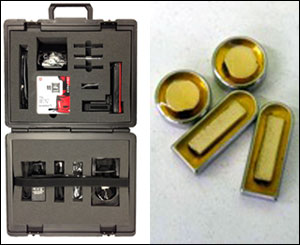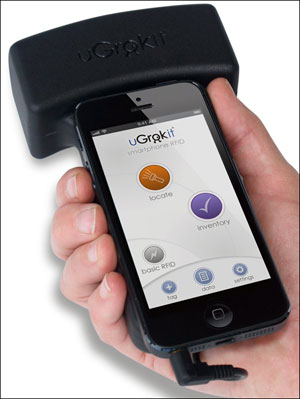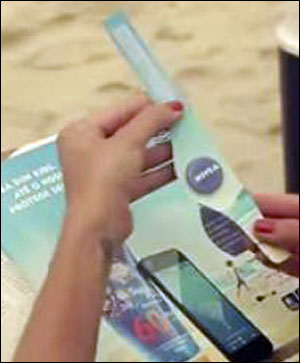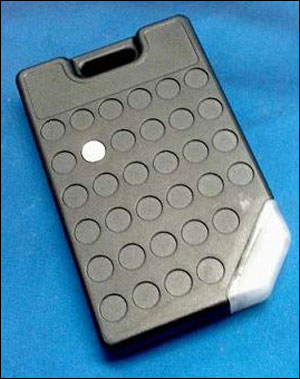The following are news announcements made during the past week by the following organizations:
U Grok It;
Xerafy, RFID Global Solution, Alien Technology;
Holland 1916;
Duane Reade;
Nivea, StickNFind Technologies;
Convergence Systems Ltd., HID Global; and
Qualcomm.
U Grok It Raises $600,000 in Angel Funding, Begins Manufacturing Smartphone UHF Readers
RFID startup U Grok It has announced that it has raised $600,000 in funding that will help the company move forward with production, sales and marketing of its smartphone RFID readers and associated software. The ultrahigh-frequency (UHF) EPC Gen 2 reader is designed to help small and midsize businesses use their smartphones to locate, track and inventory RFID-tagged items located at the mid-range distance (generally 6 to 10 feet away from the reader, and as much 25 feet under optimal conditions). U Grok It’s RFID reader attaches to the back of an Apple or Android smartphone or tablet, plugging into the device’s audio port. The initial solution will include the U Grok IT application and a cloud-based back-end server. UHF Gen 2 tags can be affixed to items; information about tagged items, as well as photographs, can then be entered into the app running on the smart device. The $600,000 is in the form of a convertible note, says Laura Sankey, U Grok It’s VP of sales and marketing (convertible notes are used to enable investors to invest in a company before shares of stock are issued). The note will convert to shares of stock, she explains, based on a conversion trigger that is pre-determined as part of the investment. The funding was led by a group, or syndicate, of angel investors, through FG Angels, led by venture-capital firm The Foundry Group. FG Angels maintains a site on Angel List, an online platform designed to assist startups in obtaining finding. The initial production run of Smartphone RFID readers is scheduled to be available this summer, Sankey reports, and U Grok It is now taking orders for its the readers through its sales team and online. In the meantime, the team is encouraging developers to integrate RFID features into their existing apps, and to develop new apps for business verticals using U Grok It’s open development platform, which the company says enables the easy creation of native iOS and Android apps with the benefits of UHF Gen 2 RFID.
Xerafy, RFID Global Solution, Alien Technology Partner on RFID Kit for Hospitals

Xerafy, RFID Global Solution and Alien Technology have introduced a new starter kit designed to make it easier for hospitals to test and implement RFID technology within their central services departments. The RFID technology can be used to track surgical assets, according to the three companies, and the kit provides everything needed to automate asset management, and to track surgical instruments through all storage, distribution and reprocessing processes, including autoclave sterilization. The technology can be used to locate items whose location is unknown, even if they are covered by other objects. This, the companies explain, helps to keep surgical instruments available when and where they are required, and prevents the unintended retention of foreign object (URFO) incidents, in which an item or foreign object related to any operative or invasive procedure is left within a patient. The starter kit includes RFID Global Solution’s Visi-Trac Healthcare software, designed to track assets, inventory and patients, and combines location awareness, unique identification, role-based access control and process management. The kit also includes Alien’s ALH-9011 developer kit, consisting of a handheld computer that reads passive ultrahigh-frequency (UHF) RFID tags (compliant with the ISO 18000 6-C and EPC Gen 2 standards), and runs the Visi-Trac Healthcare software. The ALH-9011 handheld features IEEE 802.11 standard wireless LAN connectivity and an integrated imager for reading 1D and 2D bar codes, including Data Matrix symbols. Finally, the kit comes with six of Xerafy’s Dash tags and six of its Dot tags, packaged in metal carriers for easy attachment to most surgical instruments via welding. The tags, Xerafy says, can be used to comply with the U.S. Food and Drug Administration (FDA)’s requirements for its Unique Device Identification (UDI) initiative for medical devices to enable automatic tracking for improved productivity, infection control and product recalls. According to the company, the tags meet all FDA rules that require most medical devices to carry a permanent, machine-readable identification mark, starting in September 2014 (see Managing Medical Devices). The Dash and Dot tags are composed of medical-grade materials that have been tested to withstand more than 1,000 autoclave cycles, the company adds. The starter kit can now be purchased from RFID Global Solution for $4,395, with different regional frequency hardware available for European and Asian customers.
Holland RFID, Xerafy Announce Oil-and-Gas Partnership
Holland RFID, the radio frequency identification arm of Holland 1916, and Xerafy have announced an exclusive partnership for the North American oil and gas industry that, according to the two companies, will focus on combining their technologies to create new, application-specific tag solutions for companies in that sector, including ATEX-certified and embedded products. ATEX is part of a European Union (EU) directive describing the equipment and work environment allowed in a setting containing an explosive atmosphere. Holland 1916 has been serving the oil and gas industries for many years, and was an early solution provider in bringing RFID to that industry, according to John Burnell, the senior marketing manager at Xerafy, which provides industrial RFID tags for on-metal usage. Holland RFID will use some of Xerafy’s existing on-metal tags, Burnell reports, but the two partners will also collaborate to optimize product designs and performance, as well as consider new product development as they see opportunities in the market. As a result of the partnership, Holland RFID will be the exclusive North American distributor of Xerafy’s RFID products to the oil and gas sector. The two companies have worked together before. Approximately a year ago, they teamed up, along with C-Logistics, to offer a new ruggedized RFID tag for metal slings and rigging equipment, designed for logistics and asset-tracking applications in the oil and gas industry (see Xerafy, C-Logistics and Holland 1916 Unveil Rugged RFID Tag for Oil and Gas).
Walgreens’ Duane Reade Drugstores Deploy Bluetooth Beacons
Duane Reade, a New York City drugstore chain owned by Walgreens, has implemented Bluetooth beacons at 10 select Duane Reade locations in Manhattan. In conjunction with the implementation, Duane Reade has updated its application for the Apple iPhone. A Bluetooth beacon is a small electronic device, generally powered by batteries, that transmits a unique ID number. The inclusion of Bluetooth beacon technology to the Duane Reade 2.0 app adds such features as notifications pushed to lock screens (user interfaces that regulate immediate access to a smart device and are often used for the display of notifications for e-mails and text messages, including date and time, and shortcuts to certain applications). In addition, the drugstore chain reports, when customers with the Duane Reade 2.0 app enter one 10 participating stores, the beacons installed at that store will prompt the app to receive coupon offers based on historical data, as well as product reviews for timely content at the point-of-decision. The enhanced Duane Reade app adds to the existing features in the Duane Reade iPhone app, including the new Weekly Ads & Coupons, Pill Reminder, DR Walk-In, Preferred Store, Shopping List, Steps and QuickPrints from Instagram. According to the drugstore chain, the app update is part of Duane Reade’s commitment to foster greater customer engagement with its value-added loyalty offers, including digital and social content initiatives tied to the in-store shopping experience. The 2.0 update, Duane Reade notes, is the first in a series of major app announcements planned for 2014, to bring the app up to par with the features of Walgreens’ iPhone app. The 10 Duane Reade stores that are testing the Bluetooth are located at 51 West 51st St., 22 West 48th St., 661 8th Ave., 4 Columbus Circle, 771 8th Avenue, 1350 Broadway, 1627 Broadway, 100 West 57th St., 1370 Avenue of the Americas and 1150 Avenue of the Americas.
Nivea Embeds StickNFind Beacons in Magazine Ads
StickNFind Technologies‘ Bluetooth beacons—active RFID tags that leverage Bluetooth Low Energy (BLE) technology—have been used as part of magazine advertisement in the April 23 edition of the Brazilian newsweekly magazine Veja. The company’s sticker tag, known as Stick-n-Find, was used in an ad conceived by advertising agency FCB Brasil for Nivea‘s SUN Kids sunscreen. Embedded on the right side of the advertisement page was a detachable bracelet made of water-resistant paper and containing the Stick-n-find Bluetooth beacon. The magazine readers were instructed to download Nivea’s phone app via iTunes or Google Play, and to then pair the bracelet with the app to help them monitor their children’s whereabouts on the beach. An alarm can be configured to trigger if a child wanders beyond a distance set in the app. Approximately the size and thickness of a U.S. quarter, the Stick-n-Find beacon comes with a standard watch battery that can be replaced, so the tags are reusable. The tag has a range of about 100 feet. According to Nivea, consumers who have not purchased the magazine with the bracelet but wish to use the app can buy the tag through the StickNFind’s website.
CSL Creates Dual-Mode Access Cards in Partnership With HID, Announces New Temperature Tag
Convergence Systems Ltd. (CSL) has announced that, in partnership with HID Global, it has created a new series of RFID access-control ID cards that operate at both ultrahigh-frequency (UHF) and high-frequency (HF). For long-range access control, all three cards in the Dual-Mode series contain a battery-assisted passive (BAP) UHF RFID tag complying with the EPC Gen 2 standard, and offering a UHF read range of 20 meters (66 feet) in free space and 5 meters (16 feet) on the human body (using CSL’s CS203 reader). For high-security applications, the cards employ 13.56 MHz HF RFID technology compatible with NXP Semiconductors‘ Mifare or HID Global’s iClass. The CS9110, made with a Mifare passive HF chip, and has an HF read range of 2.5 centimeters (1 inch). The CS9111, made with an HID eProx HF tag, offers an HF read range of 9 centimeters (3.5 inches). And the CS9112, made with an HID iClass HF tag, has an HF read range of 2.5 centimeters (1 inch). All three card models are pre-printable, the company reports, and feature an ultra-thin battery that allows them to fit into a wallet. CSL has also unveiled the CS8304 Cold Chain Temperature Logging Tag, compliant with the EPC Class 3 Gen 2 standard, which features 10 kilobytes of logging memory for the saving of temperature data throughout a trip. Built for use in the harshest, coldest and most demanding of cold chain applications, the CS8304 tag is fully enclosed by a plastic case to meet IP 67 standards, CSL reports. A light- emitting diode (LED) indicates temperature violations. Powered by a lithium battery, the CS8304 is designed to perform well amid products with high water content—which, the company notes, is typically a killer for passive tags. It can be read by any EPC Gen 2-compliant reader, measures 86 millimeters by 54 millimeters by14 millimeters (3.34 inches by 2.12 inches by 0.55 inch) and has an operating temperature of -20 degrees to +60 degrees Celsius (-4 degrees to +140 degree Fahrenheit) and a temperature accuracy of +/- 0.5 degree Celsius. The CS8304 can be configured to take temperature measurements at a rate ranging from once per second to once every 2.5 days.
Qualcomm Establishes Subsidiary as Standalone Bluetooth Beacon Company
Qualcomm has announced that its Qualcomm Technologies Inc. (QTI) subsidiary has spun off one of its divisions as a standalone company, known as Gimbal Inc., to market its Gimbal technology platform that includes Gimbal Bluetooth beacons—battery-powered tags that transmit a unique ID number via the Bluetooth Low Energy (BLE) protocol. QTI has signed a definitive agreement with a group of third-party investors to establish Qualcomm Retail Solutions (QRS), an existing subsidiary of QTI, as an independent, standalone company. Once the transaction closes, the third-party investors will collectively assume a controlling interest in the business, Qualcomm reports. QTI will remain a substantial investor, and all aspects of QRS, including the Gimbal technology platform, will be part of this transaction, with the QRS entity renamed Gimbal Inc. According to a Qualcomm spokesperson, the move to transition QRS into a standalone business is intended to provide Gimbal with greater latitude in serving its partners and customers, with the speed and agility required to capitalize on its leading industry position. While the spokesperson declines to comment on any future product development plans by Gimbal Inc., she says Qualcomm “remains committed to our vision of the Digital Sixth Sense and believes Gimbal Inc. is a business at the forefront of driving this vision. As such, Qualcomm Technologies remains very interested in the future success of Gimbal Inc., and is retaining an ongoing equity interest.” The third-party investors are funding the business via a new investment round that includes additional funding from QTI. The investor group comprises a mix of venture-capital, strategic and individual investors, including the i-Hatch LBS Fund, which includes such strategic corporate investors as Zebra Technologies Corp. and AEG. The transaction is expected to close in May 2014. Rocco Fabiano, QRS’ current president, will serve as Gimbal Inc.’s CEO. The Gimbal beacons are designed to complement GPS technology, Qualcomm explains, by allowing devices and applications to derive their proximity to beacons at a micro-level. A user’s mobile application can be enabled to search for the beacon’s transmission, and once it comes within physical proximity to the beacon and detects it, the app can notify the customer of location-relevant content, promotions and offers. The Gimbal beacons are built and configured to Apple‘s iBeacon specification. Qualcomm’s Gimbal platform is context-aware and offers geofencing, proximity, interest sensing, consumer privacy controls, a communication platform and more. For example, Gimbal Interest Sensing provides applications with inferred end-user interests, based on mobile phone usage. The solution includes Gimbal proximity beacons and a software development kit (SDK) for the iOS and Android platforms, as well as Gimbal Manager, a Web-based tool for managing geofences, privacy, profile rules, content, distribution, data and analytics.




